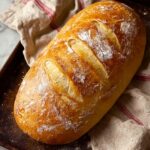Description
This classic Italian bread recipe yields a crusty, golden brown loaf with a soft, elastic interior. Perfect for sandwiches or as an accompaniment to any meal, the bread uses simple ingredients and traditional yeast fermentation for a flavorful and satisfying result.
Ingredients
Scale
Dry Ingredients
- 3 1/2 cups all-purpose flour
- 1 tablespoon sugar
- 2 teaspoons salt
- 1 tablespoon active dry yeast
Wet Ingredients
- 1 1/2 cups warm water (110°F/45°C)
- 1 tablespoon olive oil
Additional
- 1 tablespoon cornmeal (for dusting)
Instructions
- Activate Yeast: In a small bowl, dissolve sugar and yeast in warm water. Let sit for 5–10 minutes until the mixture becomes foamy, indicating that the yeast is active.
- Mix Dry Ingredients: In a large bowl, combine all-purpose flour and salt thoroughly to ensure even seasoning.
- Combine Dough: Add the yeast mixture and olive oil to the dry ingredients. Stir until the mixture starts to come together into a dough.
- Knead Dough: Turn the dough onto a floured surface and knead vigorously for 8–10 minutes until the dough is smooth and elastic, developing gluten structure.
- First Rise: Place the dough into a greased bowl, cover it with a damp cloth to maintain moisture, and let it rise in a warm place for 1 to 2 hours, or until it has doubled in size.
- Preheat Oven: Set your oven to 375°F (190°C) so it reaches the proper temperature by the time the dough has risen a second time.
- Shape Dough: Punch down the risen dough to release gases, shape it into a loaf, and place it on a baking sheet dusted with cornmeal to prevent sticking and add texture to the crust.
- Second Rise: Allow the loaf to rise for an additional 30 minutes to achieve a lighter crumb. Slash the top with a sharp knife to control expansion and create a decorative finish.
- Bake Bread: Bake the loaf for 25–30 minutes until the crust is golden brown and the bread sounds hollow when tapped on the bottom, indicating it’s fully baked.
- Cool: Transfer the bread to a wire rack and cool completely before slicing to avoid a gummy texture.
Notes
- Use warm water at approximately 110°F (45°C) to properly activate the yeast without killing it.
- Kneading develops gluten which gives the bread its chewy texture.
- Rising times may vary depending on room temperature; dough should double in size.
- Slashing the loaf before baking helps the bread expand evenly and creates a new crust texture.
- Allowing bread to cool fully helps set the crumb and makes slicing easier.
- Cornmeal dusting adds a subtle crunch and prevents sticking to the baking sheet.

